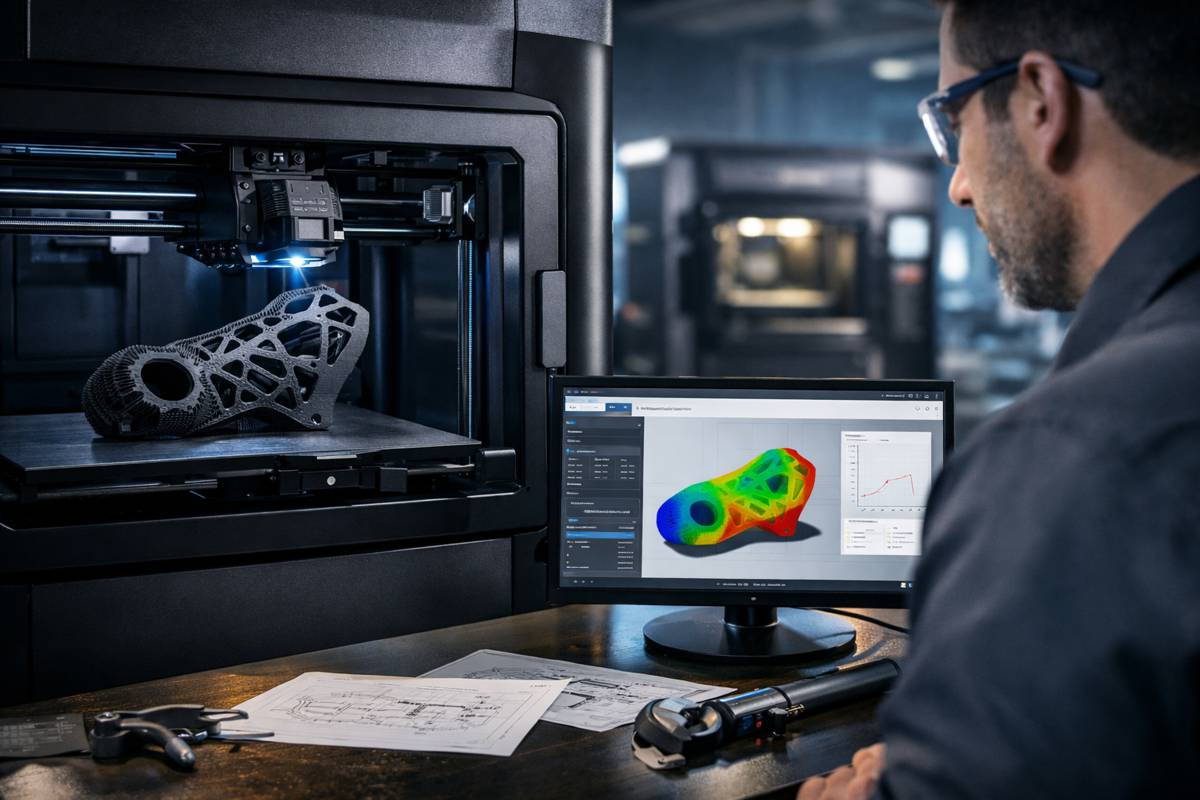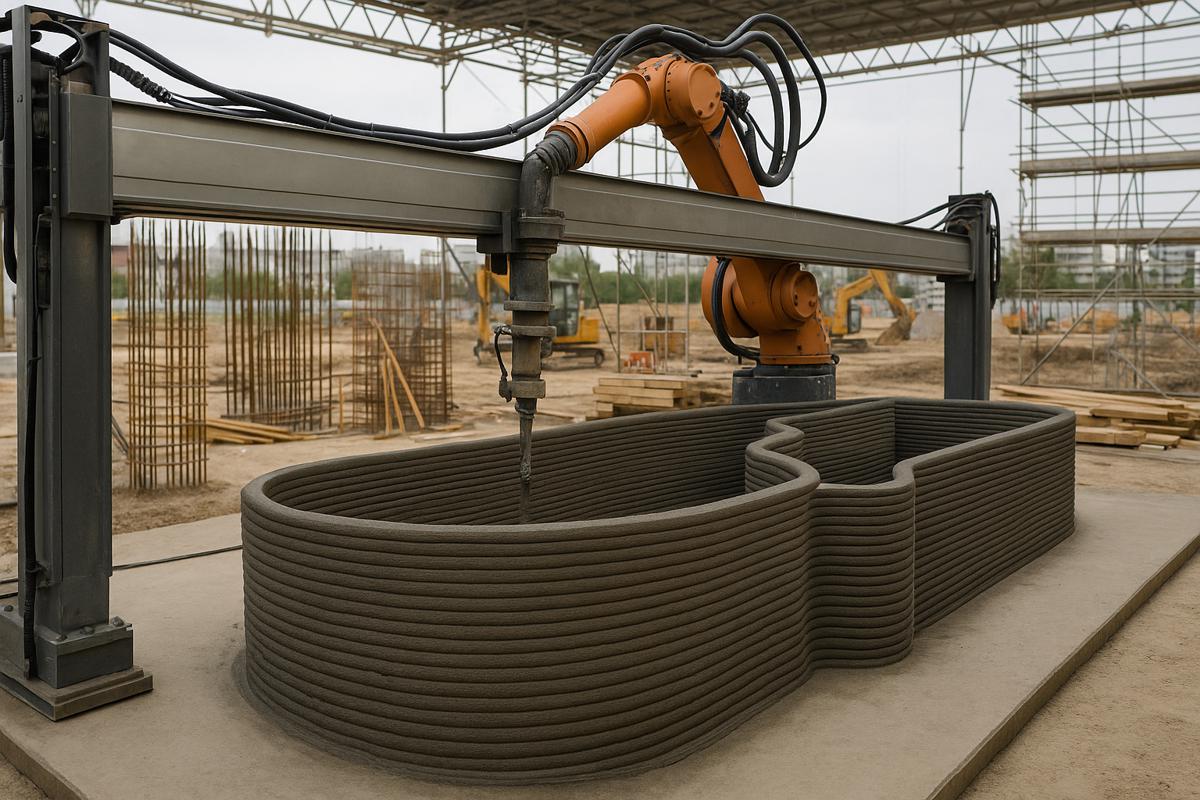VULCAN scans microscopic behaviour of 3D Printed Metal
From carbon fibre to concrete and bamboo, additive manufacturing—the industrial term for 3D-printing—utilizes many different materials and techniques. And now, with a significant need for decarbonization and alternative supply chains for converting raw materials into finished products, 3D-printed metal could make a big impact on the future of manufacturing.
A key technique in metal additive manufacturing involves “printing,” or creating layers upon layers of metal welds to build an object. It offers a more customizable, on-demand alternative to traditional methods that involve pouring molten metal into a mold or machining or cutting metal to create a shape. But developing new technology also means solving new problems.
That’s why researchers at the Department of Energy’s (DOE’s) Oak Ridge National Laboratory (ORNL) have created a one-of-a-kind automated robotic platform that allows them to study the microscopic behavior of additive metal welds in real time as they’re being created. Insights into how the welds form and behave at such a small scale will help in refining the technology for mainstream use.
“Metal additive manufacturing is a new and exciting approach to making unconventional high-performance materials that otherwise wouldn’t be possible, or at least would be very challenging,” said ORNL project lead Alex Plotkowski. “It’s highly relevant, for example, in the aerospace and automotive industries, which require complex parts that are lightweight and very strong. And similarly, for the tool and die industry, it’s important for making complicated tools with short lead times.”
Plotkowski leads a research team that is designing and deploying the experimental metal manufacturing system used at the VULCAN engineering diffraction instrument at ORNL’s Spallation Neutron Source (SNS). The SNS is a world-leading research facility powered by a linear particle accelerator that uses beams of neutrons to study materials at the atomic scale.
The experimental platform system is called OpeN-AM, with OpeN being short for operando neutrons, a term for using neutrons to study something while it’s operating, and AM for additive manufacturing.
The platform’s main feature is a 6-axis articulating robotic arm that can be equipped with a welding torch or a laser. The former—known as a wire arc system—works by feeding a wire through the end of the torch. As the wire contacts the substrate, an electric current is applied that melts the wire and creates the weld. Alternatively, the laser works by melting the substrate into a pool of liquid metal in which either a wire or powder feedstock is incorporated to create the weld.
Next to the robotic arm is a CNC—or computer numerical control—machine. CNC machines are used to cut highly complex parts with a level of precision not possible using a manual approach. The combination of the CNC machine and OpeN-AM makes the system a hybrid of additive and subtractive manufacturing techniques: the robotic deposition head adds material, and the CNC machine removes material.
The system is mounted on an adjustable platform that raises, and rotates, offering additional degrees of freedom to collect data along the X, Y, and Z planes. The platform is also outfitted with cooling channels that lower the temperature of the metal to study different conditions and expedite characterization of the welds at room temperature.
There are significant benefits to hybrid additive manufacturing in its ability to fabricate complex components quickly and efficiently; however, the process is highly dynamic and not completely understood. The materials alternate between liquid and solid states as they are exposed to extreme fluctuations in temperatures, creating permanent deformations, or microscopic imperfections, known as residual stress.
Residual stresses can often compromise the material’s performance and lead to unexpected cracks or failures. On the other hand, with a better understanding of how residual stress is created, scientist could induce stress intentionally to create performance benefits.
“There’s only so much you can learn about a material after it’s processed using traditional characterization tools. The goal of the OpeN-AM project is to provide a new, more advanced way of characterizing the process that enables us to see inside the materials as they’re being produced,” said Plotkowski.
“Neutron experiments are a key component that allow us to observe and measure changes in the materials, such as temperature, how phase transformations are happening, and how the distributions of residual stresses are evolving. These insights are critical to optimizing the technology to make materials with improved performance.”
Neutrons are an ideal research tool for these experiments because they can penetrate or pass through almost any material, including dense metals. While other research techniques are better suited for looking closely at the surface of materials, neutrons enable researchers to peer deeply into metals with densely packed atoms for an unprecedented look at a material’s internal dynamics.
The neutron forge
Aptly named after the Roman god of metalworking, the VULCAN instrument at SNS is ideally suited to study the strength of metal alloys. The neutron beamline measures the distance between atoms in metals as they’re exposed to extreme degrees of temperature and pressure, revealing how and where stress is occurring. VULCAN also features a work area large enough to study industrial applications, such as a full-sized engine.
In their experiments, the team printed, or welded, metal into simple shapes with overlapping layers of welds that were created using different patterns. In some iterations, they varied the temperatures and other process conditions to induce different phase transformations and stress patterns. The neutron data collected during the experiments will help shed light on the relationships between the processing approach, the material’s behavior, and how residual stress evolves.
In addition to collecting data from the neutron beam, multiple high-resolution and infrared cameras installed around the platform stage recorded and compared the different temperature distributions inside the materials over time.

Alleviating time and the trouble with big data
From start to finish, each experiment cycle is entirely automated by custom software. With the push of a button, the software synchronizes each component of the experiment including robotic welding, platform movement, CNC machining, active cooling, and data collection from the peripheral cameras and the neutron beam.
“One of the biggest challenges with these kinds of experiments is time. Traditionally, neutron data has to be collected at each region throughout the sample, which could easily be around several hundred locations. That requires pausing the experiment at each point for about 30 seconds, for example. That could take 8 to 10 hours and create a serious bottleneck in productivity, and we only have a limited time on the instrument,” Plotkowski said.
“That’s where artificial intelligence comes in. The team developed an AI algorithm that takes a subset of data and decides which data points to collect next. A signal is then sent to the platform, which automatically moves the sample to a new position to measure it with the neutron beam. This procedure also allows us to automatically focus on regions with the most valuable data, and to bypass the regions that are less likely to produce new information, which saves us time and storage.”
The experiments require a significant amount of computing power. A single experiment run can generate around 1 terabyte of data—not including the neutron data—which is another reason AI is an essential part of the system. The algorithm can estimate residual stress characterizations in about one-third of the time that it would typically take using traditional technology. That means many more experiments can run during the allocated time on the neutron instrument, and it also offers researchers the flexibility to make decisions and adjustments to the experiments.
“These kinds of experiments can really only be done at VULCAN. The instrument’s upgraded detectors essentially double the number of neutrons that can be counted, meaning it provides incredibly fast data aggregation,” said ORNL’s Ke An, VULCAN instrument scientist. “We can collect data down to sub-second time scales, which is critical for studying the dynamics in such extreme environments.
“And the time-of-flight technique enabled by the SNS pulsed-beam accelerator allows us to do time-resolved studies to see firsthand how the materials change over time. This system provides a rich dataset for the development and validation of computer models that will help industry using additive manufacturing to better control stress and build better components. No other place in the world offers these capabilities at this level of sophistication.”
This research was supported by “Digital Metallurgy,” an ORNL Director’s Research and Development initiative.
In addition to Plotkowski and An, the Open-AM ORNL team includes Dunji Yu (Neutron Scattering Division), Kyle Saleeby, Guru Madireddy, and Tom Feldhausen (Manufacturing Science Division), James Haley and Singanallur Venkatakrishnan (Electrification & Energy Infrastructure Division), Chris Fancher and Wei Tang (Materials Science & Technology Division), and Yousub Lee (Computational Sciences & Engineering Division).



















